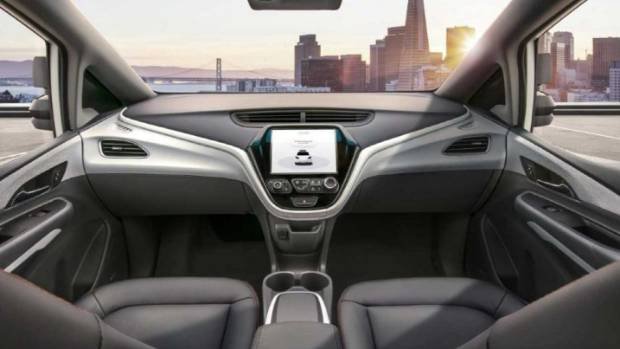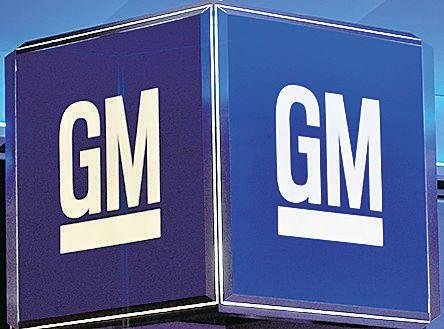General Motors reveals self-driving car without steering wheel & pedals in 2019
Image Source:

In a bold declaration, General Motors (GM) has revealed that it is making a self-driving car that will not have any traditional controls like a steering wheel or pedals.
General Motors' self-driving cars will be all electric and will help in reducing vehicle emission. A study by the company also says that nearly one of three cars on city streets at any given time is simply looking for parking. GM's technology will create better use of time and space.
General Motors unveiled the Cruise AV, a self-driving electric vehicle based on the Chevrolet Bolt EV that has no steering wheel nor pedals.
GM is apparently fully confident in the self-driving capabilities of the Cruise AV, as there will be no way for humans to take control of the vehicle. The question now is whether humans are willing to place complete trust on a computer for their road safety.
General Motors Cruise AV: Ready For Production
General Motors filed a safety petition with the U.S. Department of Transportation for the fourth-generation self-driving Cruise AV. The automobile manufacturer describes the electric vehicle as "the first production-ready vehicle built from the start to operate safely on its own," as the Cruise AV has no steering wheel, pedals, and other manual controls used by drivers.
In self-driving technology terms, the Cruise AV will exhibit what is known as "level 4 autonomy." GM is one of the companies testing the technology, alongside others that include Google parent Alphabet's Waymo and California-based startup Zoox.
GM, however, might beat all the other to the punch in getting a fully autonomous vehicle to customers for public use. The company is planning to mass produce the Cruise AV as soon as next year.
Image Source:

"We view this as being a very important next step in our plan to deploy self-driving vehicles at scale in 2019 and it's all part of our mission to move to a world of zero crashes," said GM head of storytelling and advanced technology communications Ray Wert.
GM will release the Cruise AV, without the steering wheel and pedals, in a test batch for a ride-sharing program starting in 2019. The vehicles will be traveling on a fixed route and will be controlled by a mapping system.
Is The GM Cruise AV's Self-Driving Technology Safe?
Customers may find it difficult to trust their lives to self-driving technology, especially after various reports on crashes involving autonomous vehicles. Perhaps the most high-profile incident was the first self-driving car fatality in a crash of a Tesla Model S while it was in Autopilot mode back in mid-2016, but big names such as Google and Uber have also experienced their own accidents.
However, in the 2018 Self-Driving Safety Report released by General Motors, the company noted that 1.25 million people die from car crashes every year across the world and that in 94 percent of these accidents, human error was a major contributing factor. GM believes that taking human error out of the equation will result in safer roads for everyone.
Kyle Vogt, the CEO of Cruise Automation, which is the unit developing the technology for the self-driving vehicles of GM, said that the Cruise AV will have redundant systems as backup to the main driving system. If the vehicle detects a problem, it will slow down and pull over to the roadside.
The Cruise AV was also designed to operate safely even in the presence of reckless drivers, pedestrians, and construction works.
Will you climb into a Cruise AV given the chance? Let us know in the comments section.
This is the first production car without driver controls: GM
GM President Dan Ammann said, "It's a pretty exciting moment in the history of the path to wide scale [autonomous vehicle] deployment and having the first production car with no driver controls. And it's an interesting thing to share with everybody."
The autonomous car, called the 'Cruise AV,' will not feature any manual controls either and passengers will have to completely depend on the vehicle for navigation and other tasks.
The driverless car to be used as a ride-hailing vehicle
The driverless car comes as the fourth generation of GM's all-electric Chevy Bolts.
The company claims that the car will be put to use as a ride-hailing vehicle and that it will be able to identify pedestrians, react to other vehicles on the road to avoid collisions, and even yield to emergency vehicles like the ambulance or the police van.
The car seeks to go under production from 2019
GM has also said that it aims at starting the mass production of the vehicle at its manufacturing plant in Michigan from 2019 and has petitioned the US Department of Transport for the same.
The car, currently being tested on the roads of San Francisco and Phoenix, strategically comes in the wake of the annual Detroit Auto Show that kicks off next week.
Auto manufacturing companies have intensified efforts to flood the roads with unmanned vehicles with General Motors (GM) concluding plans to build cars without a steering wheel, pedals or gear selector.
GM said the autonomous car which design has been completed, will be due for production in 2019 after the National Highway Traffic Safety Administration must have given permission to do so.
If approved, it will likely be the first production vehicle of its kind to hit the road, two years before a similar proposal from Ford.
Based on the Chevy Bolt, the electric Cruise AV will initially be employed in a ride-hailing capacity and operate within a pre-determined, well-mapped ‘geo-fenced’ area, so it won’t be entirely off the leash.
Versions of the car with driver controls are currently being tested in San Francisco and Phoenix.
They feature a large array of sensors on the roof that will be engineered to pass crash tests with the rest of the vehicle.
In a report about the project, GM details how the cars will be summoned by an app that automatically sets their climate controls and audio systems to the user’s preferences.
Along with a display on the center stack, there are infotainment screens in the headrests of the front seats for rear passengers to use.
Riders will be able to communicate with a call center with issues, and there are buttons that will stop the vehicle and allow them to exit in the event of an emergency.
And the car doesn’t just drive itself, if you forget to close the door behind you it’ll do that itself without complaint before heading off to pick up another fare.
We are careening this direction. As long as their are manual cars on the road, the opportunity for crashes will be high. People are not going to give up driving that easy. It would be nice to have a manual override option. Of course, that is given you actually own the car. For driverless car service, I would imagine it would make sense not to have that option.